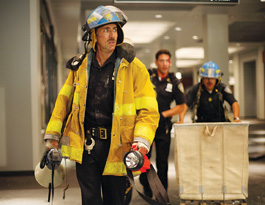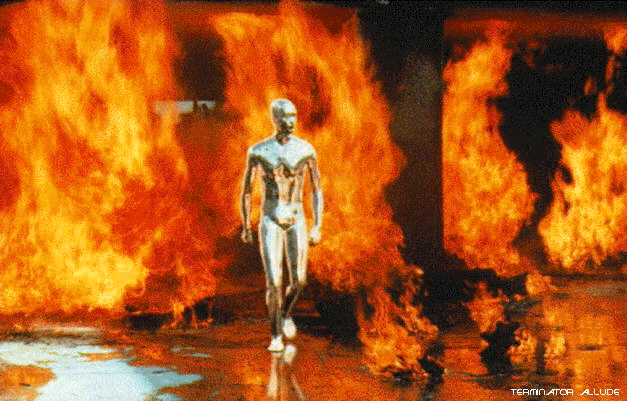Screenwriting 101 — The Act Break


asks: “I’m often confused about just where act breaks occur. Reviews often mention them as if they’re obvious, but they aren’t to me. Do you know of a good primer that would help me understand this?”
My father once described it to me like this:
In Act I, a guy gets stuck up in a tree, in Act II they throw rocks at him, in Act III he gets down from the tree.
Strangely enough, if you take out “tree” and put in “collapsed skyscraper,” you have exactly the plot of Oliver Stone’s World Trade Center, so let’s look at the structure of that.
In Act II, they literally throw rocks at him for forty minutes. He’s stuck under a ton of cement and twisted metal, he has no idea what has happened to him, he’s got his buddy pinned under a different ton of cement and twisted metal a few yards away and rocks keep falling on his head. And he has to deal with that, and we see, step by step, how he deals with that — he thinks about his family life, he thinks about his job and his friends, he hallucinates visions of the Virgin Mary. And while it’s been a while since I’ve seen the movie, I’d guess that the “Act II low-point” occurs when poor Nic has given up hope of ever getting out from under this collapsed skyscraper.
Then, in Act III, a ray of hope! Someone up top realizes that Nic is trapped under this collapsed skyscraper and we see, step by step, incident by incident, how a team of men work together to get him out. And there is much nail-biting suspense regarding if they’ll get to him in time, if the wreckage of this collapsed skyscraper will shift and smoosh poor Nic, if he’ll lose an arm or a leg or his sanity, et cetera.
So there you have it. Inciting incident: airplanes crash into the World Trade Center. Our protagonist is a simple working-class joe trying to do his job, gets caught up in the story of the century. Act I illustrates how he ends up under the collapsed skyscraper. There is escalating tension throughout Act II because, let’s face it, he’s trapped under a collapsed skyscraper and there isn’t much to go on as far as ideas for how to get out of that situation. Inevitably, despair sets in as it appears he will never get out from under the collapsed skyscraper, then, in Act III, miraculously, he does.
David Mamet put it a slightly different way: he said that Act I is “Once Upon A Time,” Act II is “Then One Day” and Act III is “But There Was One Thing That They Forgot.” So we would say that World Trade Center goes “Once Upon A Time there was a Working-Class Joe just trying to do his job with his team of Other Working-Class Joes. Then One Day a skyscraper collapsed on top of him and he worried that maybe he’d die under all that cement and twisted metal. But There Was One Thing That He Forgot, which was that, Working-Class Joe that he was, he was part of a Community of Working-Class Joes, and if there’s one thing you can say about Working-Class Joes, it’s that they are at their best when things are at their worst, and they will move heaven and earth when one of their own is in trouble.”
It’s also worth noting that not all movies have a three-act structure. Terminator 2, for instance, has a four-act structure. Act I sets the board with all the different characters: John Connor, the T-101, the T-1000, Sarah Connor, John’s evil foster parents, Sarah’s evil doctor, so forth, and sets them on their courses. Their stories all converge into a massive action sequence at the end of Act I. As Act I ends, John has survived the attack from the T-1000, is away from his foster parents and with his “new dad,” the T-101. Act II involves John beginning to understand the new rules of this new terminator setup and deciding that, in spite of what he’s been told, that they have to go get his mother, and so Act II sends John and the T-101 and the T-1000 all converging on the hospital where Sarah is being held prisoner and climaxes with them busting her out of the joint. Act III has them resting after their adventure, healing up and deciding what to do next. John decides one thing, but Sarah decides another, and Act III has, again, two teams heading to a destination with conflicting agendas. Sarah decides she’s got to kill Miles Dyson and John decides that killing is wrong no matter what the consequences. And again, just as with the preceding two acts, both teams arrive at their destination (that is, Dyson’s house) at more or less the same moment and a spectacular action sequence takes place. Through the prosecution of that action sequence (and again, here we see Cameron’s intuitive genius for the meaning of action) the stakes change. Sarah Connor is prepared to kill Dyson and John and the T-101 show up to stop her, and through the convergence of these two opposing forces, a new and surprising outcome occurs: Sarah achieves her goal of stopping the development of Skynet and does so without having to kill Dyson. (This moment is a particularly wonderful inversion because John has managed to turn the Terminator into a peaceful, protective machine but can’t control his crazy, bloodthirsty, out-of-control mother.) Act III climaxes with the destruction of Dyson’s company headquarters and yet another escape from the T-1000. Act IV is then a massive, multi-part action sequence involving trucks and motorcycles and helicopters and liquid nitrogen and molten steel and all that good stuff.
Thanks for that. Is the act structure something someone just learns to intuit, then? Does that mean that people disagree on where the act breaks are in some cases?
Occasionally I come across a definition of act breaks that is unfamiliar to me, but I don’t think it’s a subjective thing — analyzing act structure is an easily learnable skill; you just have to know what you’re looking for. Act I is, generally, every event that conspires to get the protagonist into a situation he cannot get out of, Act II is generally the development and complication of that situation, and Act III is figuring out how to get the protagonist out of the situation.
Take Star Wars(Episode 4): in Act I, Luke, a simple farm boy, comes across these droids that, as luck or fate would have it, show up to irrevocably change his life. Luke, who always wanted to get off Tatooine, is now forced (pun unintentional) to get off Tatooine. Once Luke leaves Tatooine, he has reached the point of no return — he’s in this situation now whether he likes it or not. He needs to get the droids to Alderaan, but when he gets there Alderaan isn’t there any more and he gets trapped on Death Star. Act II is about Luke’s adventures on the Death Star. The Act II low-point is the death of Obi-Wan, the one guy who Luke thought could get him out of this jam. With Obi-Wan dead, Luke feels lost and directionless — what is he going to do now that his mentor is dead and the whole Galactic Empire is after him? Act III is about him out-running the Imperial troops, getting the droids to the rebels, and the assault on the Death Star, during which Luke remembers the One Thing That He’d Forgotten, which is that the Force is a energy infinitely more powerful than the high-tech geegaws that the Empire has built, and so the little guy is able to, much like David, to strike the one blow that will fell the giant and save his people.
That all makes sense, but I wonder about the fuzziness of the boundaries: does Act I end when he finds his home destroyed, or actually when they leave Tattoine? You indicated the latter, but the former seems like more of an emotional turning point.
And I think that’s partly where I get confused. Obviously sets and scenes aren’t acts, but they can easily coincide (e.g. Tattoine: Act I, on the Death Star: Act II, attacking the Death Star Act III). So I wonder about the precision of the acts and how much it matters. The scenes on the Falcon before and after the Death Star are probably just part of Act II, which would make Mos Eisley all Act I? I imagine for after the fact analysis it doesn’t matter much, but for while developing the movie it could make a big difference, if the scoring or lighting, etc is to be done differently.
Location is an obvious indicator of an act break, but the emotional stakes are more important, which would probably put the act break of Episode 4 at the point where Luke discovers his aunt and uncle dead. At that moment he cannot go back, he must go forward and so we’re off to Mos Eisley.
When in doubt, I look at the DVD time-counter. If you’re about a third of the way into the movie, it’s probably the act break.
DVD counter method
That works only when the structure of the narrative works correctly. Some movies are a mess. And structure can be a trap — although as a hack, I believe in it utterly.
–Ed.
Re: DVD counter method
It’s a trap!
…sorry.
Re: DVD counter method
Structure can be a trap if you don’t understand what it’s there for, but I’ve found structure to be the opposite of a trap — once you understand the rules, it frees you up to be more imaginative within those rules.
I’m curious: do screenwriters provide intentional act breaks in their scripts or are they just implied? I come from a theatre-heavy background and acts are far more obvious in plays. Admittedly, one-act plays or single-person performances challenge the old conventions of the multi-act play, but the transitions onstage still appear obvious in live performances (mostly thanks to lighting and sound transitions).
Great summarization, by the way. ^_^
Although there is rarely an actual line of text in a screenplay that says “WE’RE NOW STARTING A NEW ACT” the transition is usually fairly obvious on the page.
I just watched one of Ingmar Bergman’s first movies, Crisis, and in it he forthrightly declares act breaks with a narrator coming on and telling us that one part of the movie is over now and the next part is beginning. Sometimes a transition like this indicates a passage of time or a re-focusing of attention (as in Reservoir Dogs, for instance), but it’s a good bet if you suddenly see a montage that indicates “life moving on” you’ve hit an act break.
Thanks for this post, because it’s actually helpful in regards to the novel I’m currently writing.
According to the structure you just described, I recently finished Act I and am now in the early stages of Act II. And it helped me figure out how to go about Act III.
(This is important because, for the first time, I’m working without an outline. The idea behind that was to challenge myself.)